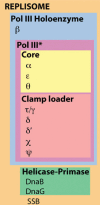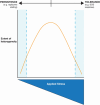DNA Replication in Mycobacterium tuberculosis
- PMID: 28361736
- PMCID: PMC5507077
- DOI: 10.1128/microbiolspec.TBTB2-0027-2016
DNA Replication in Mycobacterium tuberculosis
Abstract
Faithful replication and maintenance of the genome are essential to the ability of any organism to survive and propagate. For an obligate pathogen such as Mycobacterium tuberculosis that has to complete successive cycles of transmission, infection, and disease in order to retain a foothold in the human population, this requires that genome replication and maintenance must be accomplished under the metabolic, immune, and antibiotic stresses encountered during passage through variable host environments. Comparative genomic analyses have established that chromosomal mutations enable M. tuberculosis to adapt to these stresses: the emergence of drug-resistant isolates provides direct evidence of this capacity, so too the well-documented genetic diversity among M. tuberculosis lineages across geographic loci, as well as the microvariation within individual patients that is increasingly observed as whole-genome sequencing methodologies are applied to clinical samples and tuberculosis (TB) disease models. However, the precise mutagenic mechanisms responsible for M. tuberculosis evolution and adaptation are poorly understood. Here, we summarize current knowledge of the machinery responsible for DNA replication in M. tuberculosis, and discuss the potential contribution of the expanded complement of mycobacterial DNA polymerases to mutagenesis. We also consider briefly the possible role of DNA replication-in particular, its regulation and coordination with cell division-in the ability of M. tuberculosis to withstand antibacterial stresses, including host immune effectors and antibiotics, through the generation at the population level of a tolerant state, or through the formation of a subpopulation of persister bacilli-both of which might be relevant to the emergence and fixation of genetic drug resistance.
Figures




Similar articles
-
[Frontier of mycobacterium research--host vs. mycobacterium].Kekkaku. 2005 Sep;80(9):613-29. Kekkaku. 2005. PMID: 16245793 Japanese.
-
[Future prospects of molecular epidemiology in tuberculosis].Kekkaku. 2009 Dec;84(12):783-4. Kekkaku. 2009. PMID: 20077862 Japanese.
-
DNA Replication Fidelity in the Mycobacterium tuberculosis Complex.Adv Exp Med Biol. 2017;1019:247-262. doi: 10.1007/978-3-319-64371-7_13. Adv Exp Med Biol. 2017. PMID: 29116639 Review.
-
DNA metabolism in mycobacterial pathogenesis.Curr Top Microbiol Immunol. 2013;374:27-51. doi: 10.1007/82_2013_328. Curr Top Microbiol Immunol. 2013. PMID: 23633106 Review.
-
De Novo Emergence of Genetically Resistant Mutants of Mycobacterium tuberculosis from the Persistence Phase Cells Formed against Antituberculosis Drugs In Vitro.Antimicrob Agents Chemother. 2017 Jan 24;61(2):e01343-16. doi: 10.1128/AAC.01343-16. Print 2017 Feb. Antimicrob Agents Chemother. 2017. PMID: 27895008 Free PMC article.
Cited by
-
The Error-Prone Polymerase DnaE2 Mediates the Evolution of Antibiotic Resistance in Persister Mycobacterial Cells.Antimicrob Agents Chemother. 2022 Mar 15;66(3):e0177321. doi: 10.1128/AAC.01773-21. Epub 2022 Mar 15. Antimicrob Agents Chemother. 2022. PMID: 35156855 Free PMC article.
-
Stable Regulation of Cell Cycle Events in Mycobacteria: Insights From Inherently Heterogeneous Bacterial Populations.Front Microbiol. 2018 Mar 21;9:514. doi: 10.3389/fmicb.2018.00514. eCollection 2018. Front Microbiol. 2018. PMID: 29619019 Free PMC article. Review.
-
Understanding Metabolic Regulation Between Host and Pathogens: New Opportunities for the Development of Improved Therapeutic Strategies Against Mycobacterium tuberculosis Infection.Front Cell Infect Microbiol. 2021 Mar 16;11:635335. doi: 10.3389/fcimb.2021.635335. eCollection 2021. Front Cell Infect Microbiol. 2021. PMID: 33796480 Free PMC article. Review.
-
Targeting DNA Replication and Repair for the Development of Novel Therapeutics against Tuberculosis.Front Mol Biosci. 2017 Nov 14;4:75. doi: 10.3389/fmolb.2017.00075. eCollection 2017. Front Mol Biosci. 2017. PMID: 29184888 Free PMC article. Review.
-
The RecA-NT homology motif in ImuB mediates the interaction with ImuA', which is essential for DNA damage-induced mutagenesis.J Biol Chem. 2025 Feb;301(2):108108. doi: 10.1016/j.jbc.2024.108108. Epub 2024 Dec 18. J Biol Chem. 2025. PMID: 39706264 Free PMC article.
References
Publication types
MeSH terms
Grants and funding
LinkOut - more resources
Full Text Sources
Other Literature Sources

